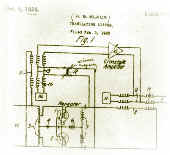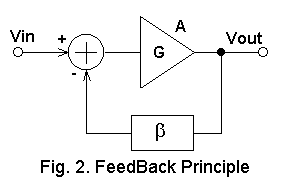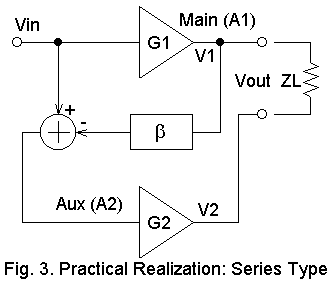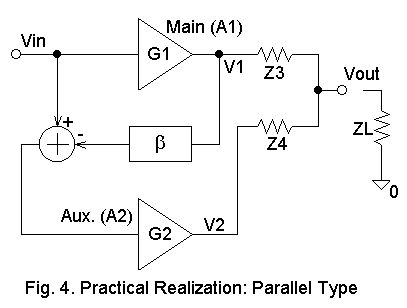FeedForward Concepts

In the Dec. 77 issue of IEEE Spectrum [1] Harold S. Black wrote:
"In 1921, the major task at the Western Electric Company's old West Street laboratories in New York City was to improve the Bell System's new open-wire telephone system. I discovered that the system's push-pull repeater amplifiers were a major source of trouble. No one knew how to make amplifiers linear or stable enough in those days, and consequently they were subject to an intolerable amount of distortion. Starting from 1921 and during the next two years, I spent many weekends and evenings reading all I could about the unwanted generation of products. At 2 a.m. of March 17, 1923 I restated my own problems as follows: Remove all distortion products from the amplifier output. In doing this, I was accepting an imperfect amplifier and regarding its output as composed of what was wanted plus what was not wanted. I immediately observed that by reducing the output to the same amplitude as the input, and subtracting one from the other, only the distortion would remain. The distortion could then be amplified in a separate amplifier and used to cancel out the distortion in the original amplifier output. This isolation and elimination could be accomplished with two biconjugate networks as a three-winding transformers or.....".
In a power amplifier we can write the input-output relationship as follows:
(1) Vout=GVin+e
In this equation G is the amplifier's gain and e the error, i.e. distortions, noise and so on. Feed-Back amplifiers can solely reduce the error by the amount of Feed-Back Factor 1+Gb and for stable performance the magnitude and phase of Gb (the loop gain) must be carefully controlled, that is |Gb| must be reduced to unity before f(Gb) becomes 180° . This means that the entity in error reduction, for a feedback amplifier, is frequency dependant and more and more ineffective when the frequency raises. Further, reducing the gain G and the error e by the same entity, Feed-Back amplifiers cannot improve the signal-to-noise ratio.

Feed-Forward amplifiers are more promising from a Error-Reduction point of view: because the mathematical relationships of signals inside the system are addittive we can obtain (at least teoretically) a full error nulling; further, there is no closed loop to form a potential instability. Fig. 1 shows the feed-forward block-diagram in the original Black's conception. A1 is the Main, that is the power amplifier and A2 is the Auxiliary amplifier. A1 is designed for efficiency and A2 for linearity criteria. The input-to-output relationship is now:
(2) Vout=(G1+G2-G1G2b)Vin
=1/b
if G1b=1 and/or G2b=1
In real world, Feed-Forward amplifiers cannot totally cancel the error because A2 is not a perfect amplifier (i.e. without distortion), further, the signal delay attempts to the perfect cancellation mechanism.

It's very difficult, but not impossible, to apply Feed-Forward Error Cancellation in Black's form in Audio Power Amplifiers, even though pratical applications in Radio Frequency [2] and Micro Wave exists. The main difficulty lies in the engineering of power summing network in audio range. "Topological Escamotages" exist for nulling or reducing the influence the summing network influence. In fact, Audio Community is convinced that the omission of true biconjugate output summing network is generally necessitated by practical considerations when high-quality error feed-forward audio power amplifiers are considered [3]. Figs. 3 and 4 shows series and parallel addition of the two output signals. In Fig. 4 we have:
Vout ~Z3V1+Z4V2
Vout/Vin~Z3G1+Z4(G2-G1G2b)
~1/b
if G1b=1 and/or G2b=Z3/Z4
Unfortunately the lack of conjugacy between the outputs results first in mutual interaction between A1 and A2 and second in the formation of an undesiderable negative feed-back loop around A2 with potential regeneration problems. Schematics in Figs 3 and 4 rely completely on the low output impedance of A1 and A2 to prevent instability problems, therefore the only practicable way with this approach is to make A1 and A2 Feed-Back amplifiers, further, using negative Feed-Back in the Feed-Forward scheme variation we can obtain tight matching of parameters (that is precise and time invariant gains in both the amplifiers).

For best results A2 must be a Class A amplifier while A1 design is focused on the high-power Class AB side. Feed-Back and Feed-Forward techniques can be combined to produce an high-power, low distortion audio power amplifier.
Recently [4], a Feed-Forward amplifier close to Black's Form which uses an audio transformer as output summing network as been presented. Nevertheless its insertion is in an unconventional way (in the feedback loop of the auxiliary amplifier), it permits to "by-pass" a lot of problems of standard approach.
Readings
| Basic Concepts | ||
| Feed-Forward Error orrection in Power Amplifiers | J. Vanderkooy and S.P. Lipshitz | JAES, Vol. 28, Nr. 1/2, Gen. Feb. 1980; |
| Inventing the Negative Feed-Back | H.S. Black | IEEE Spectrum, Vol. 14, pp. 55-60 (1977 Dec.); |
| Topological Escamotages | ||
| Reducing Distortion by 'Error add-on' | A.M. Sandman | Wireless World, vol.79, p.32 (1974 Oct.); |
| CurrentDamping Audio Amplifier | P.J. Walker | Wireless World, vol.81, p.p. 560-62 (1975 Dec.); |
| Amplifier Systems with Quasi-FeedForward Control | K.B. Klaassen | Electron. Lett., vol. 11, pp 400-401 (1975 Aug.); |
| Practical Realizations | ||
| A MOSFET Power Amplifier with Error Correction | R. Cordell | JAES, vol. 32, nr. 1/2 (1984 Jan/Feb); |
| Design and Construction of a FeedForward Error-Correction Amplifier | S. Takahashi | JAES, vol. 29, nr 1/2 (1981 Jan/Feb); |
| Audio Design leaps Forward? | Giovanni Stochino | Electronics World + Wireless World, pp 818-827 (1994 Oct.); |
References
| 1 | Inventing the Negative Feed-Back | H.S. Black | IEEE Spectrum, Vol. 14, pp. 55-60 (1977 Dec.); |
| 2 | Error Controlled High Power Linear Amplifiers at VHF | H. Seidel and H.R. Beurrier | Bell Sys. Tech. J., vol. 47, pp 651-772 (1968 May/June); |
| 3 | Feed-Forward Error orrection in Power Amplifiers | J. Vanderkooy and S.P. Lipshitz | JAES, Vol. 28, Nr. 1/2, Gen. Feb. 1980; |
| 4 | Audio Design leaps Forward? | Giovanni Stochino | Electronics World + Wireless World, pp 818-827 (1994 Oct.) |
|
What did you
think of this article? |